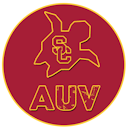
Who Are We?
We are a group of 21 undergraduates, graduates, and alumni of USC that have spent the last year dedicated to creating an autonomous underwater vehicle (AUV) to compete for a yearly competition called RoboSub. Although we have competed in the past, in 2019 our previous AUV, USCTurtle, sustained damage during the competition. But rather than repairing USCTurtle, we decided to take what we learned from USCTurtle and design a new sub called Manta Ray. So for the past few years, we have made completely new mechanical, electrical, and software components for Manta.
What Do We Do?
Robosub is an international competition where hundreds of student led groups create an AUV that demonstrates its autonomy through several realistic tasks under a new theme every year. This year the theme for the competition was a TV series called Stargate SG-1 and requires the AUV to do several tasks such as flipping a coin and shooting a torpedo at a target. To learn more about the tasks and competition, check out the homepage for RoboSub here.
Manta Documentation
Electrical Stuff

The electrical team focused on key AUV functionalities by completing the vehicle's main printed circuit boards (PCBs), designing electronics for GPS-coordinate data logging, analog signal conditioning circuits for a passive sonar system, and digital signal processing (DSP) algorithms for direction-of-arrival calculations. The main PCBs were designed to be versatile, serving as two of the four main boards, reducing the required designs. The team utilized I2C cable driver circuits to ensure signal integrity in long cable runs for the GPS sensor interface. The analog signal conditioning circuits included a preamplifier, variable gain amplifier, and digital-to-analog converters for gain control. The DSP effort resulted in an algorithm to determine the direction of arrival for a pulsed sinusoid in a three-hydrophone array. Further work will focus on signal detection to improve performance for the competition.
Mechanical Stuff

The Manta Ray, incorporating learnings from the USCTurtle, addresses the issue of unreliable electrical connections by housing all main electrical components within a larger hull, reducing the need for costly waterproof connections and improving sensor signal clarity. The Manta Ray's reliable and easily repairable hull serves as the core of the submersible, allowing for future expansion. It consists of three segments: a center segment with interchangeable sealed panels for easy access and repairs, and two transparent cylinders providing visibility and easy detachment for swift troubleshooting and repairs. Modularity remains a key design goal for the Manta Ray, allowing for easy swapping of auxiliary mechanisms and reusing the base hull for future competitions. The hull and wings feature numerous mounting points for components, adjustable motor mounts, and specially designed mounting locations for tasks such as torpedoes and object manipulation. Truss-like frames and easily interchangeable panels facilitate modifications to the interior, while rails on the lower hull enable mounting larger components.
Software Stuff

The AUV software team at USC dedicated the past year to writing code from scratch for the AUV, as there was no existing code or documentation to utilize from previous years. They focused on researching and developing the basic code architecture, utilizing the Robot Operating System (ROS) as middleware, the You Only Look Once (YOLO) model and Oriented FAST and rotated BRIEF (ORB) algorithm for computer vision, and a proportional-integral-derivative (PID) control system with an inertial measurement unit (IMU) and computer vision for stabilization. The lack of a functional sub necessitated the use of simulation through UUV Simulator, with efforts made to accurately represent the Manta Ray. A simpler computer vision system was developed using the Zed API, YOLOv4 Tiny model, and ORB feature detector for object detection and localization. The guidance, navigation, and control relied on PID controllers, a Kalman filter for navigation, and a trajectory generator based on an external GitHub repository. The software team successfully achieved their goal of creating the necessary software for safe operation of the Manta Ray in the water.
Find us on Campus
Hedco Neurosciences Building Basement, University of Southern California, Los Angeles, CA 90007
